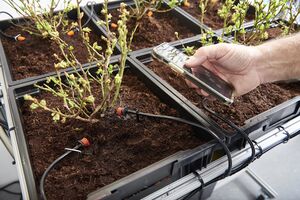Climate change and sever weather is the primary challenge facing year-round berry production in Canada. Our solution to address this challenge is to couple an indoor farm and solar photovoltaic shielded outdoor farm, which is net zero energy to produce berries year round with high yields, nutrient, and sensory quality. The systems can be can be attached to the retail locations to provide zero-mile food supply. Our solution will provide maximum yields ,enhanced nutritional and sensory quality with minimum production expenses. Furthermore, the system will be modular scalable, and adaptable to various locations and extreme climate conditions. The core idea is to couple an agrotunnel with agrivoltaics. An agrotunnel is an earth and vegetation covered tunnel that will hold high-density vertical aeroponic hybrid systems using high-efficiency spectrally optimized LED grow lights. We already have experimental evidence this works physically, but the economics can be a challenge because of the electricity costs depending on the location. To improve the economics and decrease the electricity costs, the agrotunnel and surrounding area will be covered with adjustable partially-transparent solar photovoltaic arrays. These arrays are described as agrivoltaics due to the co-location of agriculture and photovoltaics. Furthermore, the arrays will be used as shields to protect the outdoor plants from extreme weather, create a microclimate to conserve water, and provide all of the electricity needed to run the lights, water pumps and heat pumps inside of the agrotunnel. This makes the system portable to most locations within Canada. The strawberries, blueberries, raspberries, blackberries, ground cherries and salmon berries will be monitored with computer vision systems and also be tested in outdoor columns that are exposed to three levels of partially-transparent solar cells in agrivoltaic arrays to find the optimal conditions for outdoor use and compare them to the growth performance available internally.
This project is funded by the Weston Family Foundation as part of the Homegrown Challenge.
The Team[edit | edit source]
Joshua Pearce, PhD, Western University
Co-applicants:
Soodeh Nikan, PhD, Western University
Raymond Thomas, PhD, Western University
Publications[edit | edit source]
- Agrivoltaic Agrotunnel Publications
Come for a Visit[edit | edit source]
Collaborators[edit | edit source]
- Kim Parker, Food Security Structures Canada
- Greg Whiteside, Food Security Structures Canada
- Janice Kelsey, SolarCities
- Tabatha Siu, Vertical Green
- Jody Spangler, Adragone Aeroponics
WIRED[edit | edit source]
The agrivoltaic agrotunnel is part of Western Innovation for Renewable Energy Deployment (WIRED)
In the News[edit | edit source]
- Harvest season is upon us, and the future of Canadian farming is ripe with possibility. (And on that farm, there was a… farmer, engineer, and robotics expert!) Global Newswire
- Northern News
- Home Grown Challenge
- C'est la saison des récoltes et l'avenir de l'agriculture canadienne regorge de possibilités. (Et dans cette ferme, y'a... des exploitants agricoles, des ingénieurs, des experts en robotique!) Le Lizard
- Joshua Pearce: Boosting food productivity and power by optimizing the use of sun Western Engineering News
- Agriculture et énergie : alliées ou ennemies? ICI Radio Canada
- Radio Canada Mini
- Western hosts inaugural Cleantech Conference CTV

- Protein bars from recycled plastic bottles? An indoor farm on wheels? Western prof gets innovative with green tech Toronto Star
- 加拿大环保狂人回收塑料瓶制成蛋白棒 还有可移动室内农场!? Lahoo
- Every week is harvest season in Western-designed hybrid farm Western News
- Western University Extends Berry Season with Zero-Mile Agriculture Mirage News
- Net zero, zero-mile agriculture system extends berry growing season Education News Canada
- High-tech London, Ont.-area farm delivers fresh produce all year. Could it be an answer to high grocery costs? CBC News
- 'Ripe with possibility': Innovative local agrotunnel effort bears fruit London Free Press
- London team tackling year-round food production as part of national competition Tech Alliance
- Net zero energy hybrid farm system extends growing season The Brighter Side
- CAN (ON): Weston Family funded projects sees flourishing results from Innovation project Vertical Farm Daily
- Weston Family funded projects sees flourishing results from Innovation project Horti Daily
- Net-zero vertical farm aims to solve a growing berry problem New Atlas
- Chaque semaine est la saison des récoltes dans la ferme hybride conçue par l'Occident Yumda (French)
- Jede Woche ist Erntezeit in der westlich konzipierten Hybridfarm Yumda (German)
- El revolucionario invento para cultivar fresas todo el año: placas solares transparentes y un gran ahorro de aguaEl Espanol
- Hybridfarm ermöglicht ganzjähriges Ernten PCTipp (German)
- Paneles solares transparentes y gran ahorro de agua News ES Euro (Spanish)
- Western University Canada: Jede Woche ist Erntezeit in der Hybridfarm für Beeren Fruit Net (German)
- Every week is harvest season in Western-designed hybrid farm Agritech Tomorrow
- Agrotunnel, nuevo sistema solar de cultivo de interior que puede producir fresas durante todo el año en casi cualquier lugar EcoInventos
- Agrotunnel : l’invention d’une serre solaire pour produire des fruits « frais » toute l’année NeoZone
- Hybridfarm ermöglicht ganzjähriges Ernten Com Magazine
- How the Agrotunnel Could Solve Canada’s Berry-Growing Problem CE Agworld
- Vertikálna farma chce vyriešiť problém rastúcich bobuľových plodín Techpedia
- Những Nông Trại Cao Kỹ Sản Xuất Nông Phẩm Suốt Năm ThoiBao
- Kanadas katsetatakse aastaringseid vertikaalkasvuhooneid – näib, et toimivad Post Times (Estonia)
- Jede Woche ist Erntezeit in der westlich konzipierten Hybridfarm BVLK (German)
- Nuevo sistema solar de cultivos de interior Agrositio
- 加拿大研「Agrotunnel垂直農場」 或實現全年生產漿果 Bastille Post
- Agro-tunnels could be the solution to economic food problems in parts of Canada RFD TV
- Der Agrartunnel: Neue Wege in der Landwirtschaft UmWelt
- A new trajectory: Climate change rapidly impacting Canadian agriculture Western News
Progress on the First Agrivoltaic Agrotunnel in the World[edit | edit source]
The Agrotunnel is on campus and being finalized for experiments to commence January 2024.
-
The start of the fabrication of agrotunnel (Obviously in Canada).
-
The start of the fabrication of agrotunnel (Obviously in Canada).
-
Building the outside of the agrotunnel.
-
Building the agrotunnel wall - first half.
-
Exterior shell of the agrotunnel finished.
-
Construction of second half of agrotunnel underway.
-
Interior painted shield paint and temporary travel walls installed.
-
The first half of the agrotunnel arrives at ICFAR to become part of WIRED.
-
The second half of the agrotunnel arrives at ICFAR.
-
Two halves of the agrotunnel installed together!
-
Interior finishes inside agrotunnel at Western University
-
Agrotunnel at Western assembled and finalizing exterior.
-
Agrivoltaic agrotunnel completed with POSCAS units in front. Photo credit Kathryn Hollinrake and the Weston Family Foundation.
In Operation[edit | edit source]


How tos[edit | edit source]
Deliverables[edit | edit source]
Ensuring completion of all by Dec. 31, 2024 (Pearce)
- Complete a study on the most effective design and installation approach for photovoltaic systems that can be integrated next to or into the roof of the agrotunnel, based on energy modeling for agrivoltaic-agrotunnel
- Complete a study and validation on the design of a computer vision-based system for automatic detection of disease, fruit, leaves, and sizes
- Optimizing Strawberry Disease and Quality Detection with Vision Transformers and Attention-Based Convolutional Neural Networks
- (artificial Alex)
- (artificial CNN Alex, Kimia, Joshua)
- Implement and test the computer vision-based automated monitoring tools on indoor-grown plants (Kimia, Amita)
- Build, implement and test a system for automated monitoring of plants grown outdoors (via agrivoltaics) (Uzair, Koami)
- Measure and calculate the growth, yield, greenhouse gas emissions, nutritional, organoleptic, and functional properties of plants grown in the system (Amita, Eric, Raymond - engineering: Ali, Max)
- Complete a study on the impact of 24-7 spectrally tuned lighting on growth, yield, greenhouse gas emissions, nutritional, organoleptic, and functional properties of plants grown in the system (Amita, Eric, Raymond - engineering: Ali, Max)
- Complete a study on the impact of photovoltaic cells with various transmission values and/or spectrally selective outdoor agrivoltaics (Uzair, Eric)
- Complete a life cycle analysis study for the Shepherd Phase system (Shafquat,Nima, Koami, Riya)
- Complete life cycle economic analysis of a commercial scale agrivoltaic agrotunnel (Amita, Shafquat, Kashish)
Outreach[edit | edit source]
- Outreach for Agrivoltaic Agrotunnel
-
Art exhibit by Cheuk Lam Belle Li at the Northern Tornados Project, also exhibited at Western's Science Rendezvous to over 3,000 children in 2024.





























